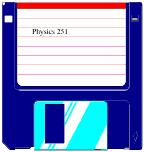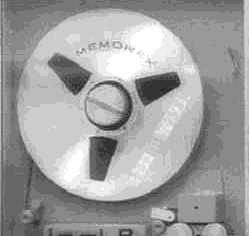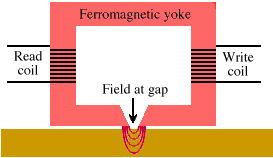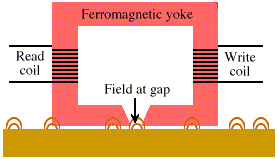 |
 |
 |
 "What is Physics Good For?"
"What is Physics Good For?"
Extra credit is available at the end of this page. Please respond before 9 AM, Monday, October 30th, 2000.Returning to a common theme, physics is good for inventing and improving valuable devices that make all of our lives better and, if we do the inventing, make of us very very rich. One of the most important industries built on magnetic technology is magnetic recording. Actually, magnetic recording is so large and diverse a category that we are really talking about several industries and many different technologies. This document will provide only the barest overview of a rich and rapidly expanding area. First, let's distinguish among some of the basic industries and technologies that fall under the Magnetic Recording umbrella.
Digital systems differ from analog in that they store the information in the form of discontinuous magnetic signals. To make a digital recording of music, in addition to the pieces described above, the digital recording system also needs a "brain" that converts the analog electrical signal into a code of on and off electrical signals (bits) after step 1. These are recorded as a discontinuous magnetic bit pattern. Then, after the magnetic bits are read in step 3, the brain must decode them and reproduce an analog electrical signal for the loudspeakers. Data storage systems are always digital. However, they are in some ways less complicated. On a computer, most of the information (except sound files) remains in digital form. Thus, there is no need to convert from analog to digital and back.
IBM introduced the first digital data recording system (the IBM 726 Tape Unit) in 1952. This was the original "half-inch tape drive." Before that time, punched cards were the only available method for recording computer programs and data. Half-inch tape drive quickly became an industry standard. For many years, if a film maker or other visual artist wanted to show a computer, the spinning half-inch tape reels were among the most popular images. It is hard to believe now, but until the 1980's, most people had never seen an actual computer.
The difference between analog and digital can be understood in terms of the difference between telephone (analog) and telegraph (digital). When you speak into your phone, it converts the pitch and volume of your voice into an electrical signal of proportional frquency and amplitude. The other persons phone inverts the process. For telegraph, the operator converts your message into a series of discontinuous soundsthe dits and dahs (dots and dashes) of a morse code message. These are transmitted, and an operator on the other end decodes the message.
A third important distinction is the form and content of the magnetic material on the medium. For instance most tapes of any kind have "particulate" media. That is, the magnetic material is in the form of small particles which are stuck to a plastic tape by some kind binder. The content of the particles has evolved over the years. Early cassette tapes used ferric oxide particles. Since then, chromium dioxide and pure iron particles have been used. Floppy disks are also coated with a particulate medium, and early hard disks were as well. However, the high storage density hard disks that are available today have a continuous coating of magnetic material. In fact, the surface of a hard disk is a complex set of layers each of which has a specific purpose. In a current hard disk, the "recording layer" which is composed of a cobalt alloy such as Co-Ni-Pt is less than 100 nanometers thick.
Underneath the distinctions, at the level where the magnetic signal is recorded and played back, all of these technologies rely on Ampere's Law for writing and (with a few recent exceptions) on Faraday's Law for reading. The basic device is the "read/write head." In its simplest form, the read/write head consists of a single ferromagnetic yoke with a small gap at one edge and two coils wound around it. When the write coils (right coils) are energized Ampere's law says a magnetic field is produced. The yoke is magnetized by this field
producing a very large "fringe" field at the gap. This field magnetizes a small region of the magnetic medium just below. The medium, which is magnetically hard, retains that
mangetization after the head field is removed.
When it comes time to read the recorded signal, the process works in reverse. Now, as the tape passes by the magnetic field of the bit partially magnetizes the yoke. As the magnetization of the yoke chages, Faraday's Law says that a small electrical signal is induced in the read coils. This signal is amplified and decoded (if data) or sent to an output device such as a loudspeaker.
You can get a lot more information about this subject on the internet. Here are a few search enginesAnd here are a few good links to get you started. Research Questions (1 point extra credit each!)
This site is made possible by funding from the National Science Foundation (DUE-9981111). |
 The first distinction to make is between analog and digital recording. Analog systems record a continuous signal (such as music or video) by recording a magnetic signal that is proportional to the original. Thus, the magnetic signal is continuous as well. The basic elements of this scheme are
The first distinction to make is between analog and digital recording. Analog systems record a continuous signal (such as music or video) by recording a magnetic signal that is proportional to the original. Thus, the magnetic signal is continuous as well. The basic elements of this scheme are

 Our next important distinction is: random vs serial access. A cassette tape (or any other tape) is a "serial access" device. That is, only one piece of the data, music, or other recorded information is near the playback mechanism at a time. If the tape is fully rewound, you have to scan through most of it to get to information near the end. On the other hand, a floppy disk is never "rewound" it spins continuously on its axis, and the playback mechanism (read head) can be moved back and forth along a radial line. Therefore, any piece of information can be located quickly. Devices such as the floppy disk, hard disk, and cd-rom, music cd, and vinyl records are said to provide "random access." Other serial devices are VHS tapes, DAT tapes, and open reel computer tapes (the kind often seen spinning ominously in the background of old science fiction movies).
Our next important distinction is: random vs serial access. A cassette tape (or any other tape) is a "serial access" device. That is, only one piece of the data, music, or other recorded information is near the playback mechanism at a time. If the tape is fully rewound, you have to scan through most of it to get to information near the end. On the other hand, a floppy disk is never "rewound" it spins continuously on its axis, and the playback mechanism (read head) can be moved back and forth along a radial line. Therefore, any piece of information can be located quickly. Devices such as the floppy disk, hard disk, and cd-rom, music cd, and vinyl records are said to provide "random access." Other serial devices are VHS tapes, DAT tapes, and open reel computer tapes (the kind often seen spinning ominously in the background of old science fiction movies).

 Thus, a bit (or a small segment of an analog signal) is recorded.
Thus, a bit (or a small segment of an analog signal) is recorded.

